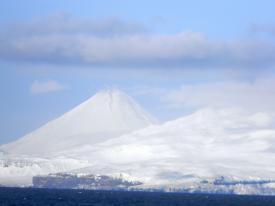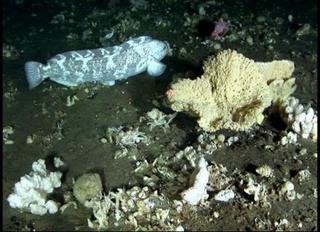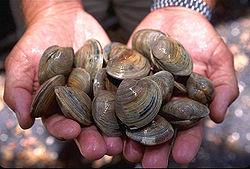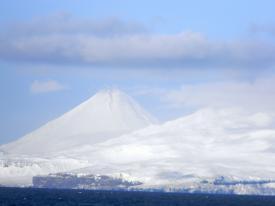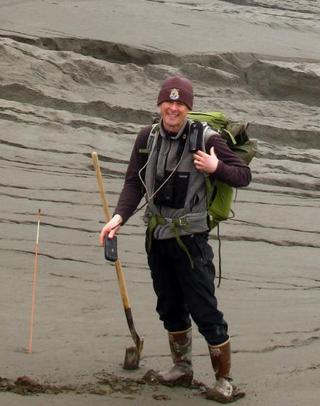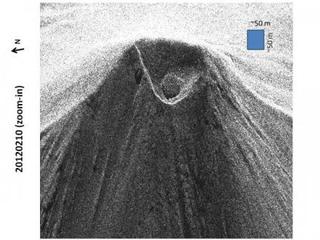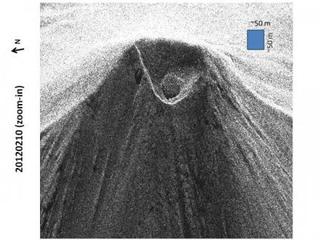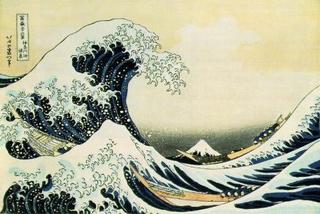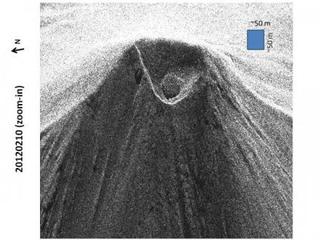New Dome Growing in Cleveland's Crater
By Stephanie Joyce
Thursday, March 29 2012
A new lava dome is forming in the crater of Cleveland Volcano. In response, scientists at the Alaska Volcano Observatory bumped the aviation alert level from yellow to orange on Wednesday.
It’s the fifth time since July that the Observatory has raised the alert. A series of small eruptions earlier this month removed the lava dome that had been forming since January. None of the eruptions produced a significant ash cloud and there’s been no activity at the volcano since March 13.
Research on Bering Sea Canyons Sheds Light on Coral's Role in Ecosystem
By Alexandra Gutierrez
Thursday, March 29 2012
Using a tiny submarine, a group of scientists have finally been able to get a good look of what actually goes on in the Bering Sea’s canyons. In the process, they discovered a new species of sponge and got a better idea of how deep-sea corals serve as a habitat for some of Alaska’s commercial fisheries.
The National Oceanic and Atmospheric Administration, the University of California Santa Barbara, and Greenpeace undertook the project. John Hocevar, who is Greenpeace’s Oceans Campaigner and one of the lead authors of the study. He says that the research was important because little is known about how the canyon’s corals fit into the ocean ecosystem.
Paralytic Shellfish Poisoning Research Gets Recognition
By Alexandra Gutierrez
Monday, March 26 2012
For years, Bruce Wright and Ray RaLonde have been keeping a close eye on clams and mussels collected in the Aleutian region. They’ve collected samples from subsistence users and tested them for levels of paralytic shellfish poisoning toxins. Now the Alaska Forum on the Environment has honored the two scientists with a major achievement award for their project.
Wright is a senior scientist with the Aleutian Pribilof Islands Association, and RaLonde is an aquaculture specialist with the Alaska Sea Grant Marine Advisory Program. They teamed up about a decade ago, and during the course of their work in the Aleutians, they saw spikes in PSP levels in places like Unalaska, Akutan, and King Cove. By tracking toxin levels, the project aimed to reduce the fatal risk involved with subsistence shellfish harvesting. Alarm over PSP levels reached a peak in 2010, when multiple cases of suspected paralytic shellfish poisoning were reported in Southeast Alaska over the course of one summer.
Cleveland Alert Level Lowered
By Stephanie Joyce
Friday, March 23 2012
Scientists at the Alaska Volcano Observatory have lowered Cleveland Volcano’s aviation alert level. The restless Aleutian volcano exploded three times in a week earlier this month. None of the eruptions produced detectable ash plumes and the Observatory says there’s been no eruptive activity since March 13.
Cleveland lies on a major international flight path and scientists raised the alert level in January after a lava dome started growing in the volcano’s crater. Gas build-up underneath lava domes can lead to explosive eruptions. Seismologist Steve McNutt told KUCB earlier this month that the recent explosions probably removed the forming dome.
Award for Refuge Biologist Saves Aleutian Research Project from Budget Cuts
By Alexandra Gutierrez
Monday, March 19 2012
Major recognition for an Alaskan scientist could mean the survival of at-risk research projects in the Aleutian Islands.
Last week, Jeff Williams, a biologist for the Alaska Maritime National Wildlife Refuge won the U.S Fish and Wildlife Service’s top award for science leadership. Williams has been working in Aleutians for over two decades, and he’s best known for his work on Kasatochi. Using the data he had previously collected on the volcano, he was able to examine how life returned to the area after a devastating eruption.
Cleveland Continues to Erupt
By Stephanie Joyce
Wednesday, March 14 2012
Cleveland Volcano has exploded for the third time in just over a week. The latest eruption on Tuesday afternoon was relatively small, according to a release from the Alaska Volcano Observatory.
Scientists at the Observatory weren’t able detect an ash cloud associated with this event or either of the other two. There’s no real-time monitoring equipment on Cleveland, but distant seismic stations picked up the blast.
Cleveland Blasts Again
By Stephanie Joyce
Monday, March 12 2012
Cleveland Volcano is continuing to erupt. On Friday afternoon, a blast shook the Aleutian volcano for the second time in a single week.
In a release, scientists at the Alaska Volcano Observatory noted that the explosion was similar in size and duration to Wednesday’s blast. There’s no monitoring network on the volcano itself, but distant seismic stations picked up both explosions.
Scientists haven’t been able to detect the ash clouds associated with either event because of cloudy conditions in the area. The Observatory says both blasts were too small to interrupt air travel in the region, although Cleveland is on a major international flight path.
Scientists say funding cuts threaten Alaska tsunami preparedness
By Stephanie Joyce
Thursday, March 08 2012
The federal government is proposing at least a million dollar reduction in funding for tsunami programs in Alaska. The agency in charge says the cuts are necessary and won’t hurt the state’s tsunami preparedness, but some scientists and officials disagree. They say the reduction in funding will weaken Alaska’s tsunami programs and leave the state’s coastal communities at risk.
The National Oceanic and Atmospheric Administration or NOAA is proposing a $4.6 million reduction in funding for tsunami programs nationwide in the fiscal year 2013. Most of those savings will come at the expense of a program that gives money to states and academic institutions for tsunami outreach, education, and research.
Seismic Stations Pick Up Cleveland Blast
By Stephanie Joyce
Thursday, March 08 2012
Cleveland Volcano has blown its top again. An explosion shook the restless Aleutian volcano at around 7 o’clock Wednesday night. There’s no monitoring network on the volcano itself, but seismic stations as far away as Dillingham picked up the signal.
Alaska Volcano Observatory seismologist Steve McNutt says that like a similar explosion in December, Wednesday’s was relatively small.

